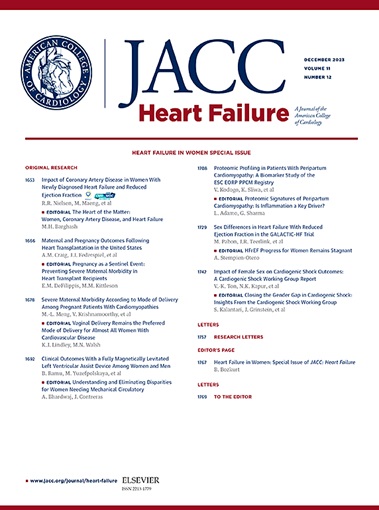多民族动脉粥样硬化(MESA)研究中冠脉外钙化与心力衰竭的关系。
IF 10.3
1区 医学
Q1 CARDIAC & CARDIOVASCULAR SYSTEMS
引用次数: 0
摘要
背景:冠状动脉外钙化(ECC)是一种常见的心血管危险因素。目的:本研究的目的是研究ECC和心力衰竭(HF)之间的关系,包括保留射血分数(HFpEF)的心力衰竭。方法:MESA(多民族动脉粥样硬化研究)参与者在基线时进行主动脉瓣、主动脉根、二尖瓣和胸主动脉钙化的计算机断层成像。通过将每个ECC站点的Agatston分数从0到1重新缩放,并将重新缩放后的分数相加,计算ECC分数。采用多变量Cox比例风险回归检验ECC四分位数与HF事件之间的关系。结果:在所有MESA参与者中,分别有3,617(53.1%)和3,192(46.9%)的ECC评分为0和>。在平均12.9±4.2年的随访期间,观察到358例HF事件,其中179例HF伴射血分数降低,135例HFpEF。在控制了人口统计学和危险因素后,ECC最高的四分位数(与最低的四分位数相比)发生HF的风险高出1.7倍(调整后的HR: 1.72 [95% CI: 1.16-2.55];P = 0.007),但在对冠状动脉钙化进行额外调整后,这一差异减弱至临界意义。与HFpEF相比,ECC最高的四分位数(与最低的四分位数相比)与HFpEF发生风险增加3倍保持独立且统计学上显著相关(调整后危险度:3.09 [95% CI: 1.45-6.60];P = 0.003),包括冠状动脉钙化。结论:ECC与HF风险增加有关,尤其是HFpEF。如果这一发现在其他研究中得到证实,ECC将有助于改进传统的HF和HFpEF风险因素估计和临床风险评估。本文章由计算机程序翻译,如有差异,请以英文原文为准。
Association of Extracoronary Calcification and Incident Heart Failure in the Multiethnic Study of Atherosclerosis (MESA)
Background
Extracoronary calcification (ECC) is a prevalent cardiovascular risk factor.
Objectives
The aim of this study was to examine the association between ECC and heart failure (HF), including heart failure with preserved ejection fraction (HFpEF).
Methods
MESA (Multi-Ethnic Study of Atherosclerosis) participants with computed tomographic imaging at baseline for calcification of the aortic valve, aortic root, mitral valve, and thoracic aorta were included. ECC score was calculated by rescaling Agatston scores from 0 to 1 for each ECC site and summing the rescaled scores. Multivariable Cox proportional hazards regression was performed to examine the association between ECC quartiles and incident HF.
Results
Of all MESA participants, 3,617 (53.1%) and 3,192 (46.9%) had ECC scores of 0 and >0, respectively. During a mean follow-up period of 12.9 ± 4.2 years, 358 HF events were observed, 179 HF with reduced ejection fraction and 135 HFpEF. After controlling for demographics and risk factors, the highest ECC quartile (compared with the lowest quartile) had 1.7-fold greater hazard of incident HF (adjusted HR: 1.72 [95% CI: 1.16-2.55]; P = 0.007), though this was attenuated to borderline significance after additional adjustment for coronary artery calcification. In contrast for HFpEF, the highest ECC quartile (compared with the lowest quartile) remained independently and statistically significantly associated with 3-fold greater hazard of incident HFpEF (adjusted HR: 3.09 [95% CI: 1.45-6.60]; P = 0.003) after full adjustment, including for coronary artery calcification.
Conclusions
ECC is associated with increased risk for HF, in particular HFpEF. If this finding is confirmed in other studies, ECC could help improve traditional risk factor estimation and clinical risk assessments for HF and HFpEF.
求助全文
通过发布文献求助,成功后即可免费获取论文全文。
去求助
来源期刊

JACC. Heart failure
CARDIAC & CARDIOVASCULAR SYSTEMS-
CiteScore
21.20
自引率
2.30%
发文量
164
期刊介绍:
JACC: Heart Failure publishes crucial findings on the pathophysiology, diagnosis, treatment, and care of heart failure patients. The goal is to enhance understanding through timely scientific communication on disease, clinical trials, outcomes, and therapeutic advances. The Journal fosters interdisciplinary connections with neuroscience, pulmonary medicine, nephrology, electrophysiology, and surgery related to heart failure. It also covers articles on pharmacogenetics, biomarkers, and metabolomics.
 求助内容:
求助内容: 应助结果提醒方式:
应助结果提醒方式:


